La Negociación Minera Hacienda Grande, Purísima y Minas de Guadalupe y Anexas
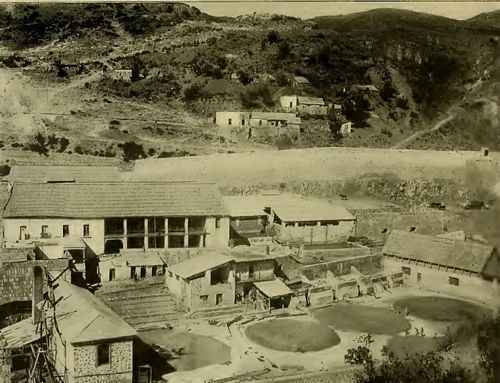

Hacienda de beneficio “Purísima Grande” - Fotografia Artistica J. Bustamente Valdes, 4a. de Matamoros Núm. 1, Pachuca
(courtesy https://ancestroscastaneda.wordpress.com)
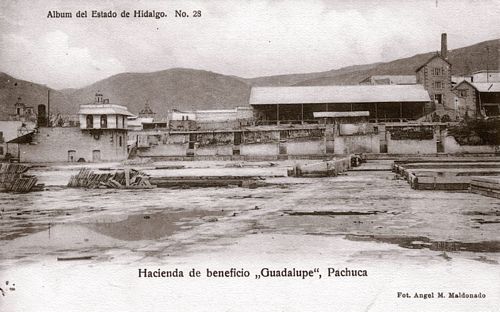
Hacienda de beneficio "Guadalupe"
1914 issue
On 24 January 1914 some of the principal merchants of Pachuca called upon the mining companies and asked them to issue script as had been done elsewhere. They explained that their sales had been cut very heavily through lack of change and that they would not only welcome mining companies’ paper but would help in any way we could suggest. All the mining companies had been experiencing great difficulties in obtaining change for payrolls, so a meeting of the eight principal companies decided, having obtained the governor’s approval, to issue a series of notes in a common format. La Negociación Minera Hacienda Grande, Purísima y Minas de Guadalupe y Anexas undertook to issue $2,000 in the first trancheAHMM, Fondo Norteamericano, vol. 41, exp. 15, Dirección General, Correspondencia, Mar 1913 – Nov 1914.
These notes were printed by the American Book and Printing Company, of Mexico City. The company had had little experience with this type of work and was under time pressure, working twenty four hours a day to complete the ordersThe Mexican Herald, 9 February 1914, and the result were disappointing.
The Purisima notes were in four denominations (5c, 10c, 50c and $1)
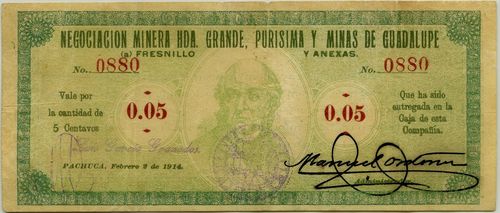
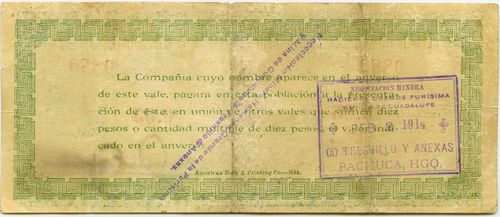
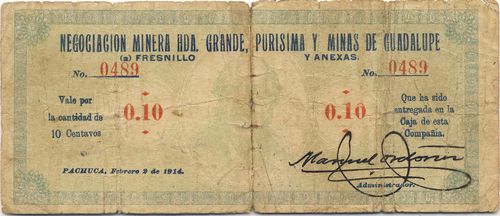
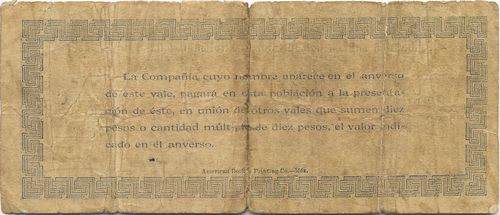
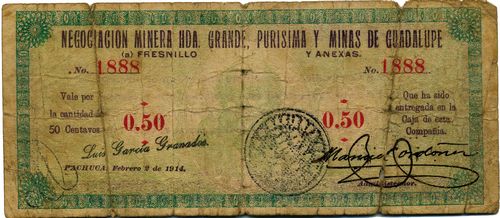

| Date of issue | Date on note | from | to | total number |
total value |
||
| 5c | after 21 February 1914 | 2 February 1914 | includes number 0880 | ||||
| 10c | includes number 0489 | ||||||
| 50c | includes number 1888 | ||||||
| $1 | includes number 360 | ||||||
They had the printed signature of Luis García Granados and were signed by Manuel Ordóñez as Administrador.
| Luis García Granados | |
| Manuel Ordóñez | 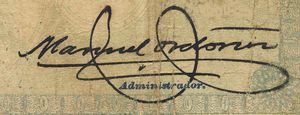 |
A further issue
The notes of the first issue were probably withdrawn, or lost acceptability, when counterfeits appeared of some notes. This is probably the reason for a couple of low value notes (5c, 10c and 20c), produced by Bouligny & Schmidt, of Mexico City, dated 10 July 1914. Known notes are datestamped September and November 1914 on the reverse.
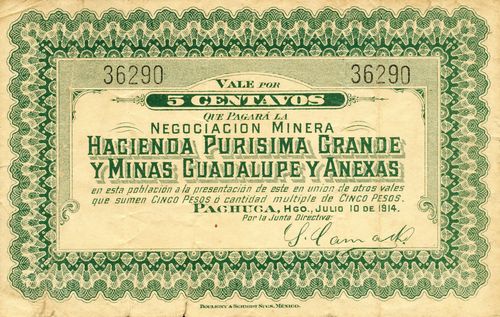
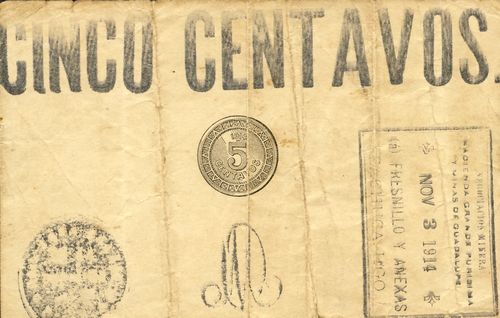
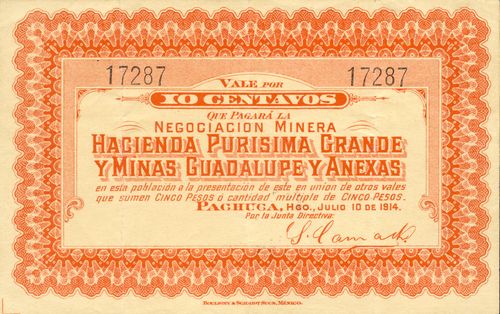

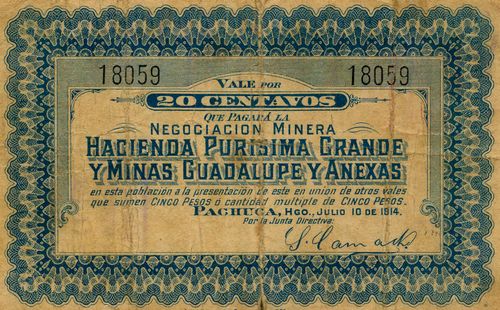

| Date on note | from | to | total number |
total value |
||
| 5c | 3 November 1914 | includes numbers 10617CNBanxico # 11220 to 36290 | ||||
| 10c | 9 September 1914 | includes number 17287 | ||||
| 1 October 1914 | includes number 23349 | |||||
| includes number 34298CNBanxico # 11221 | ||||||
| 20c | [ ] September 1914 | includes number 18059CNBanxico # 11222 | ||||
These were based on issues that Bouligny & Schmidt had already produced for the El Oro Mining & Railway Co. and The Mexican Mines of El Oro Limited, in the adjoining Estado de México. They were signed by S. Camacho for the board (Junta Directiva) and redeemable in multiples of five pesos (en esta población a la presentación de este en union de otros vales que sumen CINCO PESOS ó cantidad multiple de CINCO PESOS ).
|
He was alternate senator from Jalisco (1888-1894, 1896-1898), deputy from Guanajuato (1894 – 1898) and senator from the Federal District (1900-1914). |
 |
Cheques
The company also produced bearer cheques for $1, $5 and $5 dated from March to June 1915.
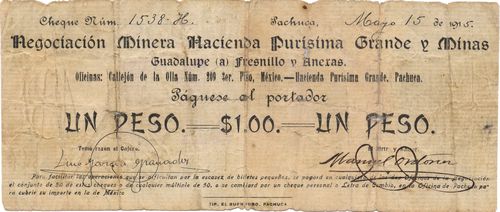
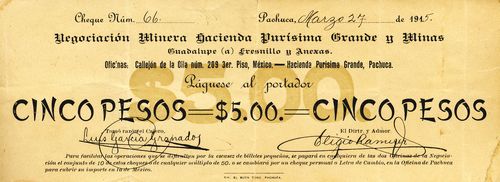
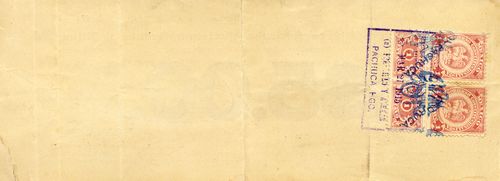


| Date on note | from | to | total number |
total value |
||
| $1 | 15 May 1915 | includes number 1538-HCNBanxico #11236 to 2235-H | ||||
| $5 | 27 March 1915 | includes numbers 66 to 75CNBanxico #11237 | ||||
| $10 | 15 May 1915 | includes numbers 1146 to 4047 | ||||
These were produced by the local printers, Tipografía El Buen Tono, of Pachuca. They were signed by Luis García Granados as Cajero and Eligio Ramírez or Manuel Ordóñez as Director y Administrador.
| Luis García Granados | |
|
Eligio Ramírez Gutiérrez was a prominent supporter of Madero and after Aquiles Serdan’s uprising in Puebla, he and some others were arrested by Mayor Acosta, of the Inspección General de Policía of the Federal District. Compromising papers were found and the prisoners were sent to Mexico CityEl Tiempo, Año XXVIII, Núm. 9,014, 21 November 1910 and accused of sedition and conspiracyEl Tiempo, Año XXVIII, Núm. 9,020, 28 November 1910. A month later they were released on bond as it was decided that their culpability was minimal or nonexistantThe Mexican Herald, vol. XXXI, no. 83, 22 December 1910; El Imparcial, Tomo XXIX, Núm. 6,108, 22 December 1910. |
|
| Manuel Ordóñez |  |

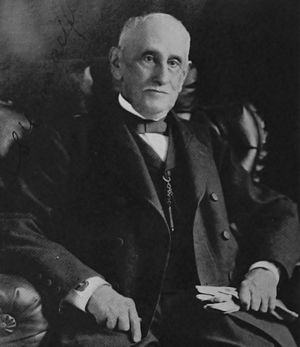 Sebastián Camacho was born in Jalapa, Veracruz in 1823. His father was a distinguished diplomat, governor and statesman who accumulated a large fortune in business with Angel Lerdo de Tejada. Sebastián gained a civil engineering degree from the National School of Mines. He was involved in the Compañía Limitada del Ferrocarril Mexicano and received concessions to develop several railway lines, was president or director of various mining companies and mints,
Sebastián Camacho was born in Jalapa, Veracruz in 1823. His father was a distinguished diplomat, governor and statesman who accumulated a large fortune in business with Angel Lerdo de Tejada. Sebastián gained a civil engineering degree from the National School of Mines. He was involved in the Compañía Limitada del Ferrocarril Mexicano and received concessions to develop several railway lines, was president or director of various mining companies and mints,